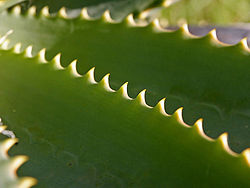Note: This is a project under development. The articles on this wiki are just being initiated and broadly incomplete. You can Help creating new pages.
Aloe vera - Ghritakumari
Aloe vera is a plant species of the genus Aloe. It grows wild in tropical climates around the world and is cultivated for agricultural and medicinal uses. Aloe is also used for decorative purposes and grows successfully indoors as a potted plant.
Contents
[hide]- 1 Uses
- 2 Parts Used
- 3 Chemical Composition
- 4 Common names
- 5 Properties
- 6 Habit
- 7 Identification
- 8 List of Ayurvedic medicine in which the herb is used
- 9 Where to get the saplings
- 10 Mode of Propagation
- 11 How to plant/cultivate
- 12 Commonly seen growing in areas
- 13 Photo Gallery
- 14 References
- 15 External Links
Uses
Asthma, Stomach ulcers, Depression, Diabetes, Skin eruptions, Blotches, Pimples, Inflamed skin, Indigestion, Liver disorders, Jaundice, Skin disease, Menstrual disturbance.[1]
Parts Used
Chemical Composition
Aloe vera includes amino acids, anthraquinones, enzymes, minerals, vitamins, lignins, monosaccharide, polysaccharides, salicylic acid, saponins, and sterols.[3]
Common names
| Language | Common name |
|---|---|
| Kannada | Lolesara |
| Hindi | Gheekumari |
| Malayalam | Kattar vazha |
| Tamil | Kathalai |
| Telugu | Kalabanda |
| Marathi | NA |
| Gujarathi | NA |
| Punjabi | NA |
| Kashmiri | NA |
| Sanskrit | Ghritakumari |
| English | Aloe vera |
Properties
Reference: Dravya - Substance, Rasa - Taste, Guna - Qualities, Veerya - Potency, Vipaka - Post-digesion effect, Karma - Pharmacological activity, Prabhava - Therepeutics.
Dravya
Rasa
Tikta (Bitter)
Guna
Guru (heavy), Snigda (unctous)
Veerya
Sheeta (cold)
Vipaka
Katu (Pungent)
Karma
Kapha, Vata
Prabhava
Habit
Identification
Leaf
| Kind | Shape | Feature |
|---|---|---|
| Simple | Triangular | The tissue in the center of the aloe-veraAloe leaf contains a gel which yields the aloe gel |
Flower
| Type | Size | Color and composition | Stamen | More information |
|---|---|---|---|---|
| Unisexual | 2-4cm long | Yellow | 5-20 | Flowers Season is June - August |
Fruit
| Type | Size | Mass | Appearance | Seeds | More information |
|---|---|---|---|---|---|
| Triangular | 7–10 mm | The fruit is the triangular capsule containing numerous seeds | Many | Fruiting season: August-December |
Other features
List of Ayurvedic medicine in which the herb is used
Orthonil, Karphoora Shilajit Bhasma, Kantavallaba Rasa, Kumar Kalyana Rasa, Kumariyasava, Chaturbuja rasa, Chaturbukha rasa, Chintamani Chaturmukha rasa, Chitrataila, Jyotishmati taila, Nagabhasma, Pradaraantaka Rasa, Purnachandrodaya, Brihat vatachintamani rasa, Manjishtaadi Taila, Makaradvaja Sindhoora, Mahaavangeshwara rasa, Mensofit, Rajata Loha rasayanam, Rasaraaja Rasa, Raasanaadi Churna, Lumital, Leucofit, Lohabhasma, Skarid, Sutikaabharana rasa, Senovila, Herbolax[2]
Where to get the saplings
Mode of Propagation
How to plant/cultivate
It is a perennial plant, growing to the hight of 1½ - 2½ ft. Its leaves are long and thick, juicy with a wheel like phylotaxy. The two sides of the leaves have thorny structure with a thorny tip.[5]
Commonly seen growing in areas
Temperate region, Waste fields.
Photo Gallery
References
- Jump up ↑ Karnataka Aushadhiya Sasyagalu By Dr.Maagadi R Gurudeva, Page no:309
- ↑ Jump up to: 2.0 2.1 2.2 "Karnataka Medicinal Plants Volume - 2" by Dr.M. R. Gurudeva, Page No.619, Published by Divyachandra Prakashana, #45, Paapannana Tota, 1st Main road, Basaveshwara Nagara, Bengaluru.
- Jump up ↑ Chemical constituents
- Jump up ↑ Plant description
- Jump up ↑ Practical palnts
External Links
- Ayurvedic Herbs known to be helpful to treat Asthma
- Ayurvedic Herbs known to be helpful to treat Stomach ulcers
- Ayurvedic Herbs known to be helpful to treat Depression
- Ayurvedic Herbs known to be helpful to treat Diabetes
- Ayurvedic Herbs known to be helpful to treat Skin eruptions
- Ayurvedic Herbs known to be helpful to treat Blotches
- Ayurvedic Herbs known to be helpful to treat Pimples
- Ayurvedic Herbs known to be helpful to treat Inflamed skin
- Ayurvedic Herbs known to be helpful to treat Indigestion
- Ayurvedic Herbs known to be helpful to treat Liver disorders
- Ayurvedic Herbs known to be helpful to treat Jaundice
- Ayurvedic Herbs known to be helpful to treat Skin disease
- Ayurvedic Herbs known to be helpful to treat Menstrual disturbance
- Herbs with Leaves used in medicine
- Herbs with common name in Kannada
- Herbs with common name in Hindi
- Herbs with common name in Malayalam
- Herbs with common name in Tamil
- Herbs with common name in Telugu
- Herbs with common name in Sanskrit
- Herbs with common name in English
- Habit - Herb
- Index of Plants which can be propagated by Seeds
- Index of Plants which can be propagated by Cuttings
- Herbs that are commonly seen in the region of Temperate region
- Herbs that are commonly seen in the region of Waste fields
- Herbs
- Xanthorrhoeaceae









